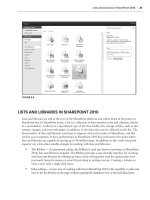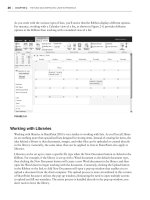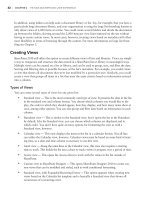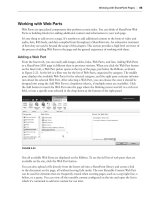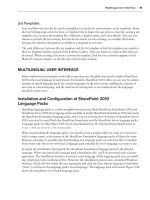Thủ thuật Sharepoint 2010 part 95 pot
Bạn đang xem bản rút gọn của tài liệu. Xem và tải ngay bản đầy đủ của tài liệu tại đây (458.57 KB, 7 trang )
716
CHAPTER 23 BraNdiNg sharePoiNt 2010
Customization and Solution Packages
One common pitfall when dealing with SharePoint branding is the topic of customization. In
SharePoint 2003, customization was known as unghosting and uncustomized pages were referred
to as ghosted, but those terms have been deprecated since SharePoint 2007.
Because branding in SharePoint frequently involves changing out-of-the-box files, customization can
happen easily (and sometimes happens unexpectedly when someone who is inexperienced is working
with SharePoint Designer). The following sections describe how these files work in SharePoint.
Uncustomized Files
When a SharePoint site is created, its files are actually instances of files from the SharePoint server’s
file system that are provisioned into the content database. When a browser visits one of these pages,
SharePoint looks in the content database and sees that the page is based on a file that resides in the
file system, retrieving it from the file system and presenting it to the user. These types of files are
known as uncustomized files, and they represent many out-of-the-box files such as master pages,
page layouts, and content pages. Different SharePoint sites on the same farm can point to the same
files on the file system as long as all of them are uncustomized.
Customized Files
Any time one of these uncustomized files is changed via the SharePoint web user interface or through
SharePoint Designer, the changed version is stored in the content database and the file becomes
customized. When a browser visits a customized page, SharePoint looks in the content database,
sees that the file is customized, and simply displays the contents of the file as it was stored in the
content database. On the face of things, this doesn’t seem too bad, but from an administrative per-
spective there can be maintenance issues with customized files.
For example, if a master page is installed via a SharePoint solution package (WSP) and activated on
a site collection as a feature, and then later that master page is customized in the site collection with
SharePoint Designer, subsequent changes to the original solution file will not affect that customized
master page. This can get even more confusing when several site collections are all based off of the same
solution package and then one of the sites is customized. The sites’ branding can become out of sync; and
depending on how long the customizations go undetected, synchronizing them could be challenging.
Using SharePoint Solution Packages to Apply Branding
If customization can cause problems, how is SharePoint Designer effectively used to create branding
without customizing everything? The answer to this is simple: SharePoint Designer can be used to
create branding on a development server or a local virtual machine that is set up to closely mimic
the production environment. When the branding files are completed, they can be packaged for
proper deployment to the production server.
This involves loading all of the master pages, page layouts, custom CSS, and images, and any other
branding assets, into a Visual Studio project and creating a SharePoint solution package (WSP).
Branding that is installed on a SharePoint server via a WSP will create files that are uncustomized.
You can learn more about creating solution packages in Chapter 13, “Adding Functionality with
Features and Solution Packages.”
Branding Basics for SharePoint 2010
717
Controlling Access to Branding in SharePoint
As an administrator, you may need to control user access to branding on a particular server. The
easiest way to control access to branding in SharePoint is to add or remove users from the Designers
group. Among other permissions, by default, users in this role have the following branding-related
permissions automatically applied to them:
Approve Items
— Approve a minor version of a list item or document.
Add and Customize Pages
— Add, change, or delete HTML pages or Web Part pages, and
edit the website using a Microsoft SharePoint Foundation–compatible editor.
Apply Themes and Borders
— Apply a theme or borders to the entire website.
Browse Directories
— Enumerate files and folders in a website using SharePoint Designer and
WebDAV interfaces.
Use Self-Service Site Creation
— Create a website using Self-Service Site Creation.
Use Remote Interfaces
— Use SOAP, WebDAV, the Client Object Model, or SharePoint
Designer interfaces to access the website.
Adding Users to the Designer Group
To add users to the Designers group follow these steps:
1. Open your SharePoint site and click Site Actions Site Settings Users and Permissions
People and groups.
2. In the Groups menu on the left-hand side of the screen, click Designers.
3. To add a new user, click New Add Users (see Figure 23-39).
FIGURE 2339
718
CHAPTER 23 BraNdiNg sharePoiNt 2010
4. From the Grant Permissions dialog, type in a username or browse for one and click Enter. If
the username is valid it will be underlined (see Figure 23-40).
FIGURE 2340
5. Click OK to add the user to the group.
Removing Users from the Designer Group
Removing a user from the Designer group is equally simple:
1. Open your SharePoint site and click Site Actions Site Settings Users and Permissions
People and groups.
2. In the Groups menu on the left-hand side of the screen, click Designers. Place a checkmark
next to the user you want to remove, as shown in Figure 23-41.
FIGURE 2341
Branding Basics for SharePoint 2010
719
3. Click Actions Remove Users from Group (see Figure 23-42).
FIGURE 2342
4.
When you are asked if you are sure you want remove the user or users from the group, click OK.
Adding Design Permissions to Individual Users
While adding users to groups is the recommended method for controlling access to branding in
SharePoint, there may be special cases for which you want individual users to have access to the
Design permission level. The following steps will set up an individual user’s permission levels:
1. Open your SharePoint site and click Site Actions Site Settings Users and Permissions
Site permissions.
2. From the Ribbon, click Grant Permissions (see Figure 23-43).
FIGURE 2343
3. In the Grant Permissions dialog, enter or browse for a username and click Enter.
720
CHAPTER 23 BraNdiNg sharePoiNt 2010
4. Under Grant Permissions, click the radio button next to Grant users permission directly, as
shown in Figure 23-44.
FIGURE 2344
5. Select the Design permission level (or any others that are needed) and click OK.
Editing Permissions in the Design Permission Level
Another option for controlling access to branding in SharePoint is to edit the individual permissions
that are available for the Design level. The permissions that are related to branding were listed at the
beginning of this section. Follow these steps to add or remove permissions from the Design permis-
sion level:
1. Open your SharePoint site and click Site Actions Site Settings Users and Permissions
Site permissions.
2. From the Ribbon, click Permission Levels.
3. From the Permission Level screen, click Design.
4. Scroll down to Permission and select the permissions that you want applied to the group.
Figure 23-45 shows some of the Permissions list.
5. When you are fi nished, click Submit.
Because SharePoint Designer is frequently used to create branding, you might
want to refer to the previous chapter to learn how you can restrict access to
SharePoint Designer.
Summary
721
FIGURE 2345
SUMMARY
In this chapter you looked at how branding works in SharePoint 2010 and how it affects SharePoint
administrators. You also learned about how customization and solution packages work, and the vari-
ous security roles that are involved in SharePoint branding. Now that you have completed the chapter,
you should have a good understanding of what branding is and how it is applied to SharePoint. Of
course, a single chapter can’t cover every aspect of SharePoint branding. For more information on
creating great-looking SharePoint 2010 sites, check out Professional SharePoint 2010 Branding and
User Interface Design by Randy Drisgill et al. (Wrox 2010).



